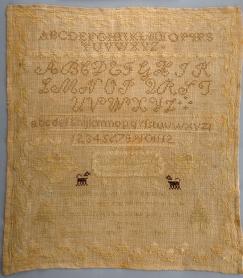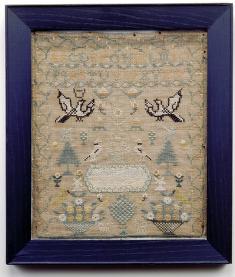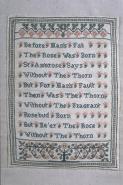|

Sophia Smith Sampler

Ruth Strong Russell (1804-1869) Sampler

Caroline Stebbins Sheldon (1789-1865) Sampler

Enchanted Forest

The Rose
|
Summary and Objective
Students will understand that hand-stitchery was commonly done by girls and women in our local (Greenfield) area as an educational tool, for decoration, and for recording or depicting information. They will do this by observing American Centuries website primary source examples of cross-stitch samplers from 1774 to the early 1900s, and discussing what it looked like, who created it, how and why it was made, and how it compares with needlework done today. Students will also make small cross-stitch samplers of their own.
Teaching Plan
Step 1.
Give a brief description of cross-stitch needlework and show the pictures of the samplers attached to this lesson. Share some modern samplers, if available.
Step 2.
Divide the class into small groups of about 5 students. Give each group a print of one of the samplers. Ask students to describe what is depicted by the stitchery, and to reflect on who might have made them, when and why they were made, who they were made for, and what they were used for. Then share each group’s reflections with the whole class.
Step 3.
Give students the text, including dates and ages of the girls and women who made the samplers. See if that information changes their understanding or raises new questions. Consider the age at which girls learned to do this. Why was it girls and women who did it? What might have been their roles in the society of their time? What might their social status and education have been?
Step 4.
For further information about some of the girls and women who stitched the samplers, share copies of “Ornamental and Useful Accomplishments: Schoolgirl Education and Deerfield Academy, 1800 – 1830”, by Suzanne L. Flynt, Deerfield, Mass: Pocumtuck Valley Memorial Association and Deerfield Academy, 1988, pp. 7-13. What new light does this shed on their understanding?
Step 5.
Have students make a small cross-stitch sampler of their own. They will need: Cross-stitch fabric (about 7”x 7” each), embroidery floss, embroidery needles, small embroidery hoops (about 4” or 5” in diameter), and graph paper. First, demonstrate how the basic cross-stitch is done. Have students design a simple sampler with their initials ( and a date of numbers). Using graph paper, plan out the size and arrangement of the letters and numbers, placing an X for each stitch in the grid. They may add a border of other designs if they like, and if there is time. Students then copy their designs onto the cross-stitch fabric with pencil or fabric marking paper.
Step 6.
Students stitch their small samplers. While they are stitching, discuss how and why stitchery was part of standard education, what ways it was used for household decoration and for recording or depicting information. What was technology like at the time these examples were stitched? What differences between the time periods of these samplers might have been relevant to these creations? Reflect on the process of doing it and why people do it today. How do the reasons compare historically and now?
|




